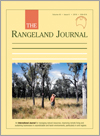RJ18062Grazing and tree ‘clearing’ alter grass-associated invertebrate assemblages in an Australian tropical grassy woodland
To paraphrase E.O. Wilson, without insects the world would collapse into chaos. In this study, we found that increasing grazing pressure altered invertebrate assemblages of a grassy woodland of the northern Australian rangelands, with fewer invertebrates where grazing was highest. Encouragingly, we found that the decomposer food cycle adjusted to match the changed resource availability, but the downside was that, in terms of absolute invertebrate abundance, the resource base for birds and other insect-eaters was diminished as grazing pressure increased.





